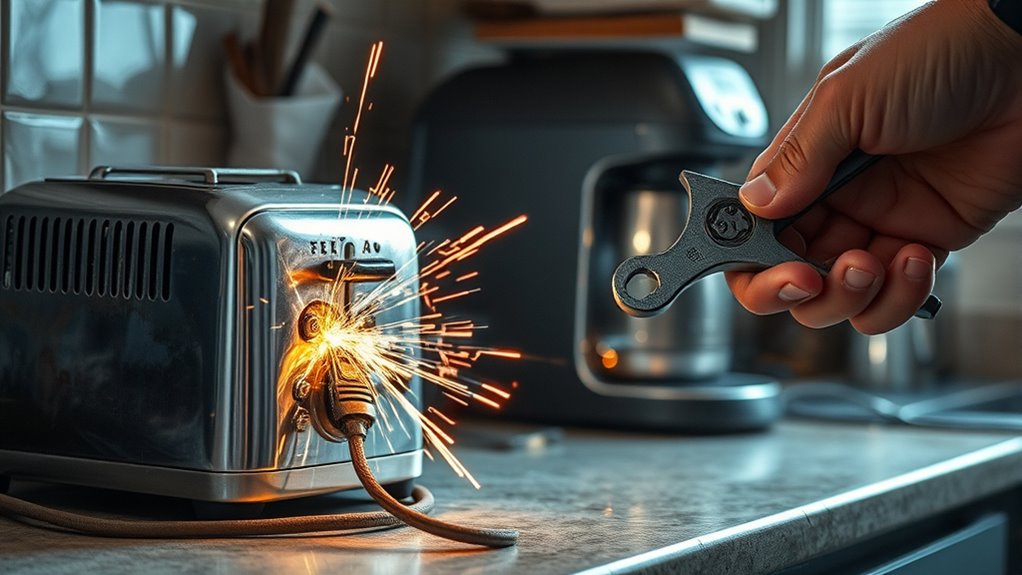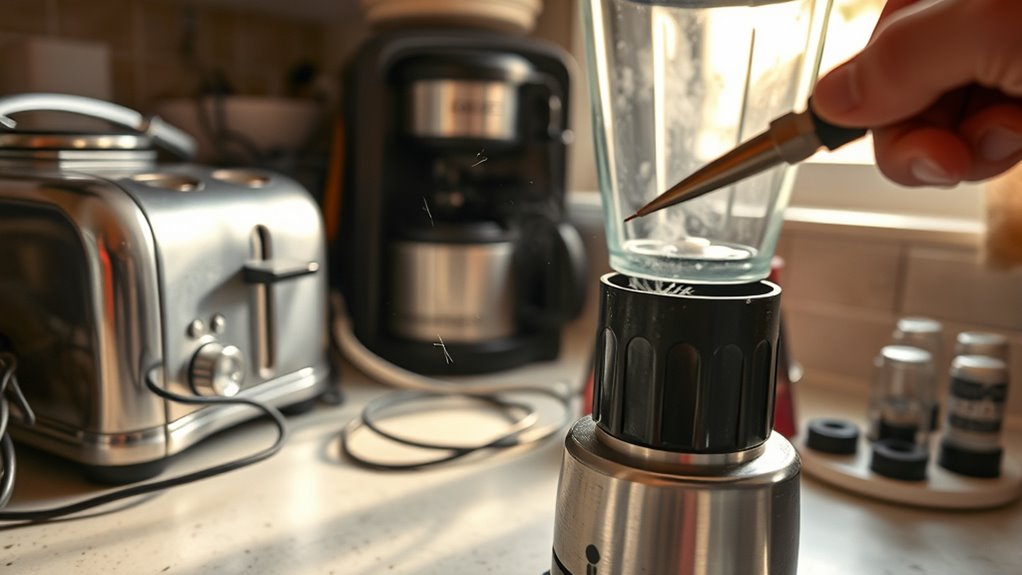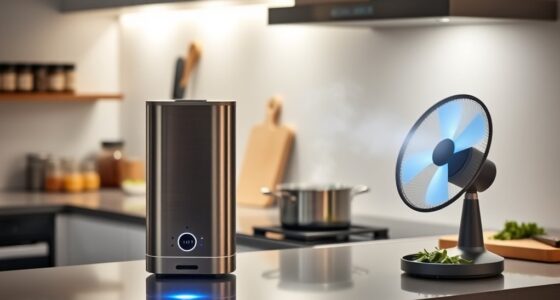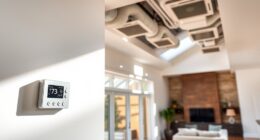Know to call a professional for small-appliance repairs if you notice sparks, burning smells, smoke, or the appliance not working after basic troubleshooting. If you see signs of electrical faults, strange noises, or internal damage, it’s best to seek expert help to prevent further issues or injuries. Avoid DIY fixes on complex parts to protect your safety and device warranty. Continue on to discover more tips for safe and effective troubleshooting.
Key Takeaways
- If the appliance shows signs of electrical faults like sparks, smoke, or burning smells.
- When basic troubleshooting steps do not resolve the issue or the appliance remains unresponsive.
- If there are strange noises, unusual vibrations, or visible damage to components.
- When you suspect internal electrical or mechanical component failure beyond simple fixes.
- If you’re unsure about handling complex repairs or working with electrical parts safely.

Small appliances can make daily tasks easier, but they sometimes break down or stop working properly. When this happens, it’s tempting to try fixing the issue yourself. However, before diving into troubleshooting, it’s essential to contemplate safety precautions. Small appliances often contain electrical components that can pose risks if mishandled. Make sure to unplug the device before inspecting or attempting repairs. Avoid using metal tools that might cause short circuits or electrical shocks, and always work in a dry, well-lit area. If you’re unsure about any step, it’s better to stop and seek professional help rather than risk injury or further damage.
Troubleshooting tips can help you identify simple problems that might not require professional intervention. Start by checking the power source—sometimes, the issue is as basic as a loose plug or a tripped circuit breaker. Inspect the cord for frays or damage; if you notice any, avoid using the appliance until it’s repaired or replaced. If the appliance powers on but doesn’t operate correctly, consult the user manual for specific troubleshooting steps. Many common issues, such as overheating or motor failure, can be caused by blockages, dirt buildup, or worn-out parts. Clear any debris, clean filters, or replace filters if needed, following manufacturer instructions carefully. Sometimes, resetting the appliance or performing a simple restart can resolve operational glitches.
If you notice sparks, burning smells, or smoke emanating from the appliance, unplug it immediately and avoid trying to fix it yourself. These are signs of potential electrical faults or internal component failures that can be dangerous if mishandled. Similarly, if the appliance still doesn’t work after basic troubleshooting, or if it’s making strange noises, it’s a good idea to consult a repair expert. Attempting repairs on complex electrical or mechanical components without proper training can lead to further damage or personal injury. Recognizing signs of electrical component failure can help prevent safety hazards and costly repairs.
Frequently Asked Questions
How Do I Troubleshoot Small Appliances Safely Before Calling a Professional?
To troubleshoot small appliances safely, start with electrical safety by unplugging the device before inspecting. Check for visible damage, loose parts, or burnt smells. Make certain cords and plugs are intact and not frayed. Perform a basic appliance inspection by testing the outlet with another device. If you notice sparks, exposed wires, or persistent issues, stop and call a professional—never risk electrical shock or further damage.
Are There Warranty Considerations When Repairing Small Appliances Myself?
You should be cautious about warranty pitfalls when repairing small appliances yourself, as doing so might void your warranty. Many manufacturers include repair disclaimers that specify unauthorized repairs can nullify coverage. Before attempting any fix, review your warranty terms carefully. If your appliance is still under warranty, consider contacting the manufacturer or a professional to avoid jeopardizing your coverage and to ensure proper, safe repairs.
What Tools Are Essential for Basic Small-Appliance Repairs?
You need essential tools like screwdrivers, pliers, a multimeter, and a utility knife for basic small-appliance repairs. But beware—DIY safety is vital. Before starting, make sure your appliance is unplugged and you understand the repair process. These common tools help you diagnose and fix issues efficiently, but knowing when to stop is key. If you’re unsure, calling a professional might save you time, money, and potential hazards.
How Long Should I Attempt Repairs Before Seeking Professional Help?
You should limit your repair attempts to about 30 minutes to an hour. If you’re not seeing progress or the issue persists, it’s time for a professional consultation. Prolonged repair time can cause further damage or safety hazards. Trust your judgment—if you’re unsure or uncomfortable, don’t hesitate to seek expert help. Prioritize safety and efficiency by knowing when to call in a professional instead of risking additional damage.
Can DIY Repairs Void the Appliance’s Manufacturer Warranty?
Think of your appliance as a delicate sculpture—you risk chipping it with DIY hazards. Attempting repairs yourself can void the manufacturer’s warranty, risking your investment. While fixing small issues might seem straightforward, mistakes can lead to bigger problems, making warranty risks more probable. If you’re unsure, it’s wise to call a professional. They protect your warranty and ensure the job’s done right without damaging your appliance.
Conclusion
Knowing when to call a professional can save you time and prevent bigger headaches down the road. If your small appliance starts acting like a stubborn mule or throws a fit that just won’t quit, it’s time to seek expert help. Think of it as calling in a skilled doctor for a stubborn ache—sometimes, a gentle touch and the right tools make all the difference. Don’t wait until your appliance’s tantrum becomes a full-blown storm—call in the pros when needed.









